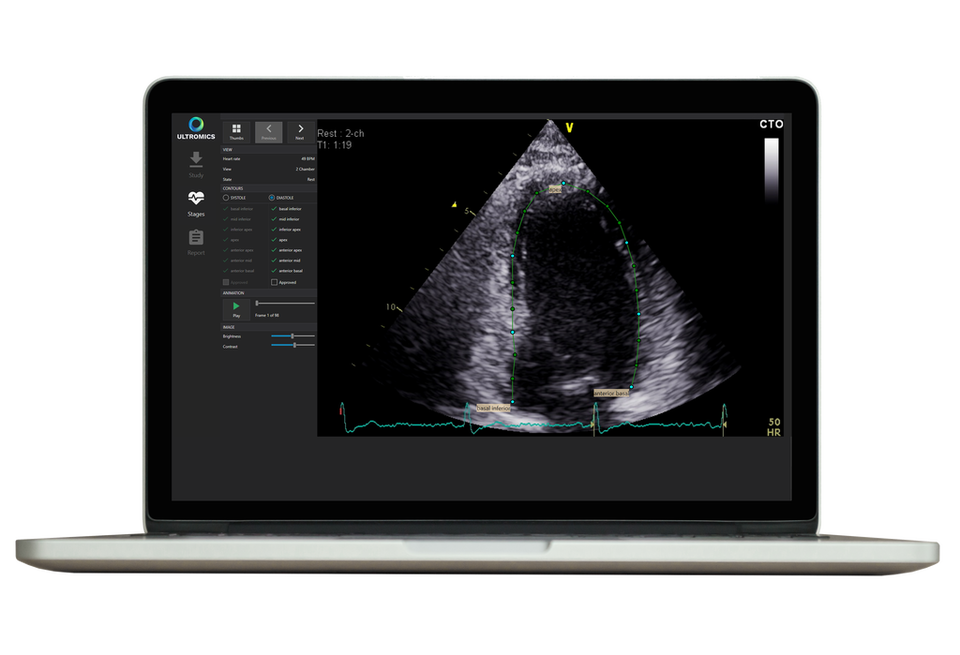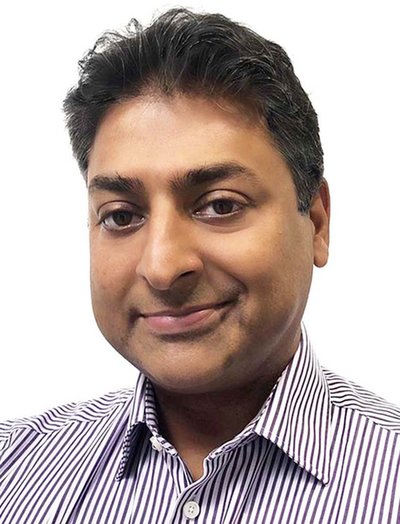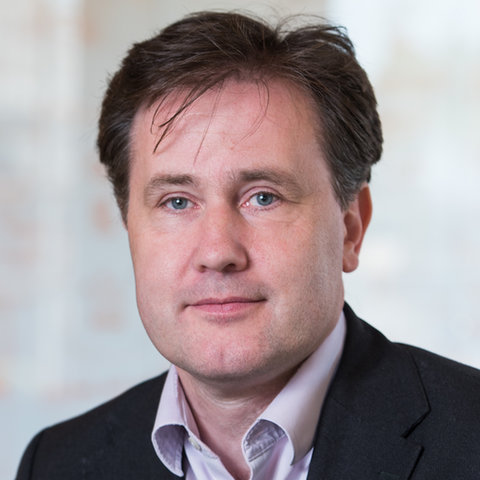Ultromics' vendor-neutral platform EchoGo applies artificial intelligence (AI) to automate the analysis and quantification of ultrasound-based heart scans, enabling clinicians to improve patient care and outcomes.

Ultromics
The Echo Companion
By Michelle Thoeny
Ultromics co-founders: Paul Leeson & Ross Upton
Many start-ups are engaged in leveraging the potential of artificial intelligence (AI) in medical imaging. While most of them are focused on guiding clinicians to acquire the correct image and/ or automating quantification of data from medical images, the use of AI to predict patient outcomes remains relatively underexplored.
It is here that Ultromics, a University of Oxford spin-out technology company, is breaking fresh ground. Co-founded in 2017 by PhD scholar Ross Upton and Paul Leeson, consultant cardiologist and head of the Oxford Cardiovascular Research Facility, the company is currently testing its AI-based image analysis system, EchoGo Core, for coronary artery disease (CAD) at dozens of hospitals in the UK.
Ultromics also received FDA clearance to sell EchoGo in the US in November 2019, and has tied-up partnerships with several leading cardiology clinical centres in the country. Although the company has a number of highly experienced ‘old hands’ like Leeson in leadership positions, it is led by the 29-year old CEO Upton, who featured in the Forbes ‘30 under 30’ list in 2019. Under Upton, Ultromics has secured $15 million in funding, and is working towards securing clearance to additionally sell its product in European markets by mid-2020. `

EchoGoCore Auto Contouring
Research shows that close to 50 percent of men and 33 percent of women globally are at the risk of developing coronary heart disease at some point in their lives. Although preventable, the signs of coronary heart disease can be very subtle—they’re noticeable in ultrasound images, for instance, where trained and experienced clinicians can pick out problems within the motion and structure of the heart’s walls.
“Identifying and picking out wall motion abnormalities during such fast heart rates (in stress echocardiograms) can be very difficult, and clinicians get it wrong one out of five times,” said Leeson, Chief Medical Officer of Ultromics, explaining the objective of the company. “A lot of cardiovascular diagnostics is based on imaging, and AI has huge potential to interpret the images in ways we just can’t do with the human eye. What we want to be able to do is augment the clinician’s interpretation of these images so that they can improve their diagnostic accuracy.”
Although the field for AI-based diagnostic and screening solutions, in cardiovascular medicine is crowded, with many companies offering software to guide clinicians in acquiring the right images and interpreting them objectively and accurately, few companies are focused on fully automating image analysis with zero variability whilst also driving early detection of disease that can make a positive difference to the lives of potential patients.
It is this gap Ultromics seeks to address with EchoGo. The proprietary vendor-agnostic system automatically detects image type, heart cycle and contouring; calculates key cardiac parameters, and provides accurate and reproducible measurements for left ventricular ejection fraction (EF), left ventricular volumes (LV) and cardiac strain. “It is still the clinician who sees a patient, takes the images and makes the final decision for that patient. EchoGo works in the background—it takes the images and provides a valuable recommendation to clinicians to augment decision-making process,” said Leeson.
Addressing a gap
Two factors are key for a company focused on interpreting cardiovascular images and predicting outcomes using AI—attention to the details captured in images, and a large and reliable database with longitudinal data about patients to square off predictions accurately.
Ultromics was well-placed to address the latter challenge courtesy of being based in the UK, where millions of echocardiographic images of patients at different points in time in different medical facilities are accessible under the centralized National Health System (NHS) database. That Leesonis a qualified doctor engaged in research helped the company secure the consent of patients to making their medical data available for commercial purposes.
The team at Ultromics analyzed 120,000 echocardiographic images from clinical trials conducted at the University of Oxford in 2017 during the development of EchoGo. It tracked patient progress throughout the next year, collecting crucial longitudinal data specifying patient outcomes. These processes demanded the company, pay close attention to the detail captured in echocardiographic images.
That its primary innovator and CEO Upton was deeply passionate about fishing helped matters. Upton’s fishing expeditions, where he has developed the accuracy to cast a bait 80 yards to an area the size of a dinner plate, avoiding the weedy areas on the lake bed, then the patience to wait up to 24 hours for any indication of a bite ensured he remained ever attentive to the slightest movements and disturbances. They helped him inculcate an ethos of patient centricity and abiding attention to detail in the development of EchoGo.
“EchoGo works by utilizing machine learning to generate contours of ultrasound images throughout the entire cardiac cycle,” explained Upton. “From those contours, we extract thousands of different features biologically relevant to the disease process. Those features are fed through to the second AI classifier which then predicts patient outcomes for EchoGo Pro.”
The attention to detail captured in echocardiographic images, access to a large and reliable database, and the involvement of experienced doctors like Leeson enabled Ultromics access to capital to develop and deploy its software in hospitals and health systems. Set up with seed funding of £2 million from Oxford Sciences Innovation (OSI), the company secured over $11 million in investments in 2018 and 2019 from OSI, Neptune, RT Ventures, GT Healthcare, Tanarra, Woodford Investment Management, Fushia, and other investors.
Driving factors


Good things come to those who bait!
Ross Upton loves fishing. In pictures: One of Upton's best catches: mirror carp (weight 28lbs)
Upton had no knowledge or experience of running a company prior to co-founding Ultromics. Born and brought up in Horsham, West Sussex (UK), he also disliked school, drove his teachers crazy over his “unfulfilled potential,” and dropped out after enrolling for an undergraduate degree at the University of Manchester till involvement in a high-speed car crash made him re-examine his life.
“I knew that if I could study something that interested me, I’d have a chance of sticking at it,” said Upton. Since he was good at science and passionate about wildlife and conservation, he signed up for an undergraduate degree and followed it up with three more: an MSc in Clinical Biochemistry, an MSc in Clinical Cardiovascular Sciences, and a DPhil in Cardiovascular Medicine at the University of Oxford.
He developed an interest in applying machine learning to echocardiography during his first masters while working on a project with a start-up. He honed his skills in the area during his second masters by undertaking a research project at the university. He turned this project into his PhD, during which he met his supervisor and Ultromics co-founder Leeson, who was similarly interested in utilizing his clinical knowledge in echocardiography to design machine-learning based algorithms and applications. They presented the findings from their research at a local conference in 2017, where an investor convinced them that “the quickest way to impact patients with your research is to spin it out as a company”.
This heralded the birth of Ultromics, a company that has achieved the rare feat of securing a clearance for commercialization in the US from the FDA within two years of its inception. In the years ahead, the company plans to pursue several tracks, much like Upton’s varied educational background. On one hand, it is engaged in making its image analysis more robust and extending the level of quantification to include regional longitudinal strains. On the other hand, it is also working on securing regulatory approvals to commercialize the product and make it available to clinicians in the UK and beyond.
The company also plans to expand into other geographic regions including Europe and Asia, where medical infrastructure is limited and there is a massive shortage of trained clinicians and sonographers. “We are working aggressively towards making our platform available on handheld ultrasound devices which hold the key in emerging markets like India, China and Africa. Not only do handheld devices significantly reduce the dependence on trained clinicians, they also allow us to make our solution available to those at the bottom of the pyramid where we can have the most impact” said Amir Hasan, Chief Commercial Officer at Ultromics.
Transitions


We are working aggressively towards making our platform available on handheld ultrasound devices. This will allow us to make our solution available to those at the bottom of the pyramid where we can have the most impact.
Amir Hasan, Chief Commercial Officer at Ultromics.
Identifying and picking out wall motion abnormalities during fast heart rates (in stress echocardiograms) can be very difficult, and clinicians get it wrong one out of five times.
Paul Leeson, PhD FRCP FESC
CMO & Founder
